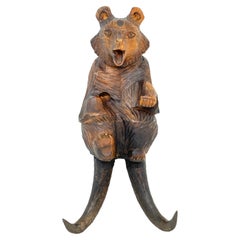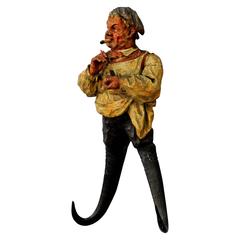Black Forest Whip Holder
Antique 1890s German Black Forest Sculptures and Carvings
Wood
Recent Sales
Antique 19th Century Austrian Black Forest Sculptures
Wood
Early 20th Century German Black Forest Wall-mounted Sculptures
Wood
Early 20th Century Austrian Black Forest Sculptures and Carvings
Wood
Antique Late 19th Century German Black Forest Wall-mounted Sculptures
Wood
Antique 19th Century Swiss Black Forest Wall-mounted Sculptures
Wood
Early 20th Century German Black Forest Wall-mounted Sculptures
Wood
Antique Late 19th Century Swiss Black Forest Sculptures and Carvings
Wood
Antique Late 19th Century Swiss Black Forest Wall-mounted Sculptures
Wood
Early 20th Century Swiss Black Forest Hat Racks and Stands
Wood
Early 20th Century Swiss Black Forest Wall-mounted Sculptures
Wood
Antique Early 1900s Austrian Black Forest Sculptures and Carvings
Wood
Antique 19th Century Swiss Animal Sculptures
Wood, Horn
Antique 19th Century Swiss Animal Sculptures
People Also Browsed
Antique 1880s Swedish Black Forest Animal Sculptures
Wood
Antique 1880s Swiss Black Forest Sculptures and Carvings
Wood
Antique 1880s Swiss Black Forest Sculptures and Carvings
Wood
Antique Late 19th Century Swiss Black Forest Chairs
Wood
Black Forest Whip Holder For Sale on 1stDibs
How Much is a Black Forest Whip Holder?
A Close Look at Black-forest Furniture
Although its name evokes a mountainous region in Germany, antique Black Forest–style furniture originated in Switzerland. In Brienz, during the early 19th century, wood-carver Christian Fischer recognized the market for tourist souvenirs and helped make the village into a wood-carving destination. The Brienz Woodcarving School was founded in 1884 and had its own small zoo for studying the anatomy of animals, depictions of which are a defining aspect of the style, also known as Brienzerware.
Whimsical sculptures, often depicting bears and other Alpine animals like stags, owls, deer and boars, characterize the work produced in the area. Along with folk art and decorative objects, Black Forest furniture included benches held aloft by bears, umbrella stands carved with acorns and clock cases adorned with scrolling oak leaves. While most wood-carvers adhered to a similar realism in their designs and woods like linden, maple and walnut, their aesthetics varied.
The F. Peter Trauffer family was known for their hand-carved bear sculptures that saw the furry mammals playing instruments, smoking pipes and engaging in all sorts of human activities. They were sometimes detailed with glass eyes and integrated into functional pieces of furniture, including chair backs and bench legs, which generations of cabinetmakers created from the 1880s to the 1950s. Walter Mader and his son Heinrich frequently carved Saint Bernard sculptures that they incorporated into furniture.
As the Black Forest furniture style spread around the world through exhibitions at world’s fairs in the 19th and early 20th centuries, the rusticity of these pieces resonated at a time of increasing urbanization, inspiring other artisans.
Find a collection of antique Black Forest cabinets, bedroom furniture, seating and other items on 1stDibs.


